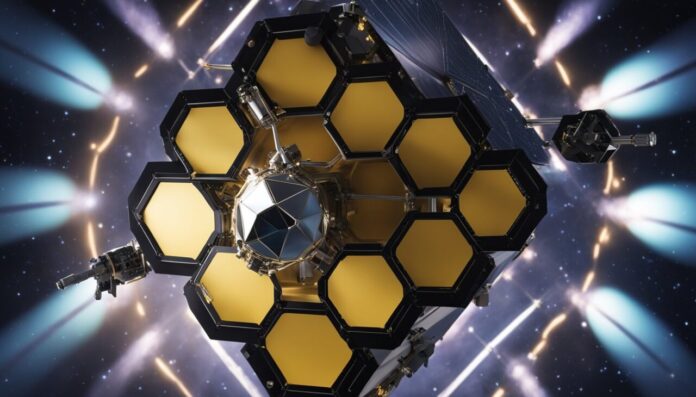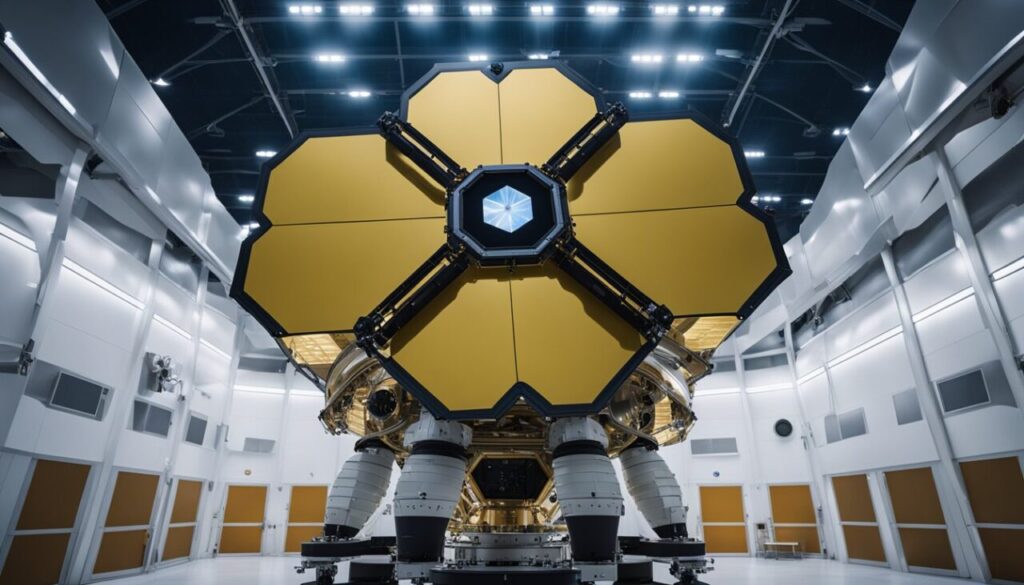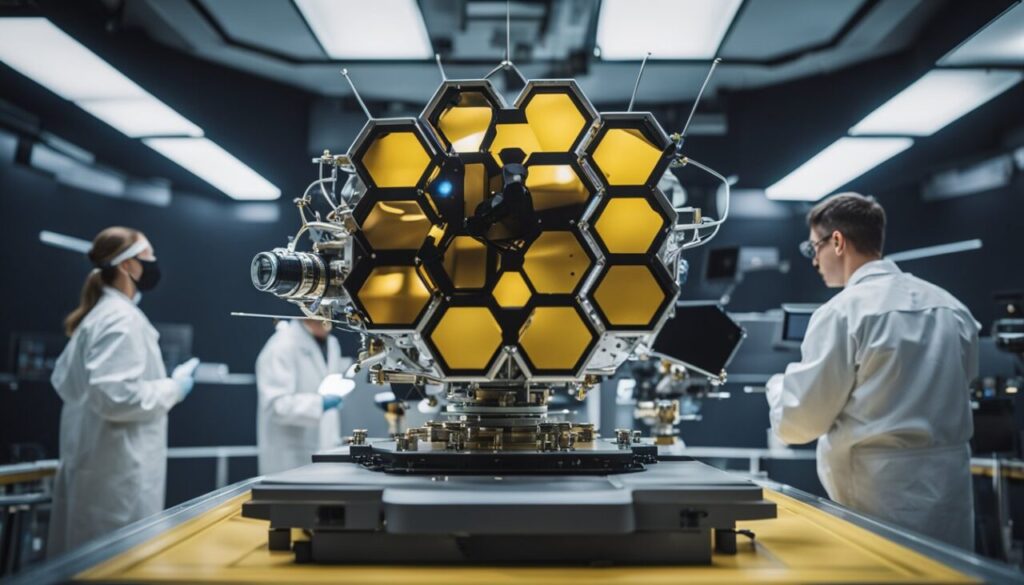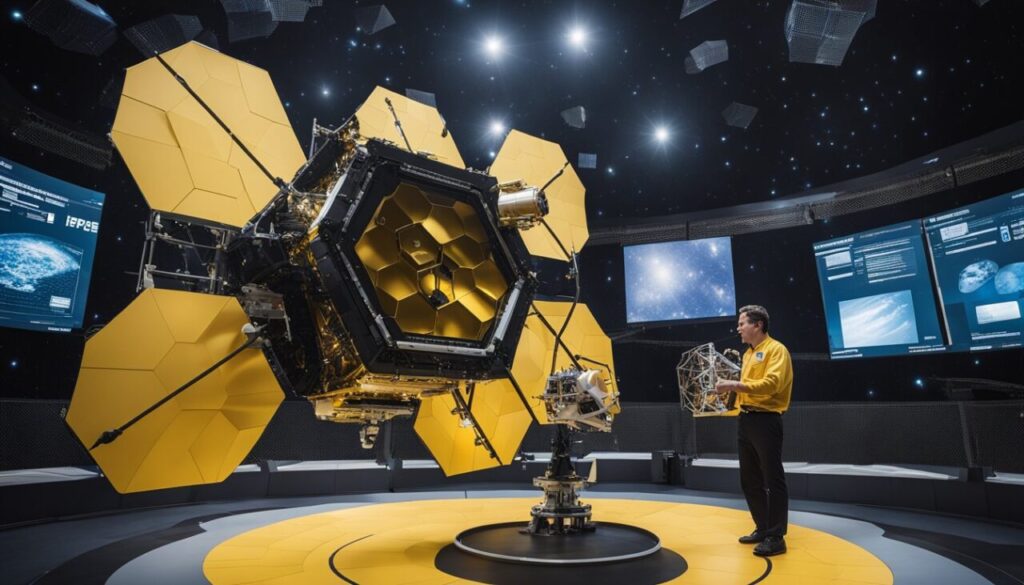
The James Webb Space Telescope (JWST) is a space observatory that was launched in December 2021. Its mission is to study the universe’s first galaxies, stars, and planets, and to search for signs of life beyond our solar system.
Ever since its launch, there has been speculation about whether the telescope has found evidence of extraterrestrial life.
Despite rumors circulating on social media, the JWST has not yet found definitive evidence of life on an exoplanet.
According to Knicole Colón, the telescope’s Deputy Project Scientist for Exoplanet Science, there has been no confirmation of any such discovery.
However, the telescope has the potential to detect signs of extraterrestrial life, and it is actively searching for them.
And so, let’s delve into more details about the telescope, its mission, recent findings, and much more.
Related:
James Webb Telescope Mission Overview

Objectives and Design
The James Webb Space Telescope (JWST) is a joint project of NASA, the European Space Agency (ESA), and the Canadian Space Agency (CSA). The telescope is named after James E. Webb, who served as the second administrator of NASA from 1961 to 1968.
The primary objective of the JWST is to explore the universe and answer some of the most fundamental questions about the cosmos.
The JWST is designed to be a successor to the Hubble Space Telescope, with a much larger mirror and a wider range of capabilities. The telescope has a primary mirror that is 6.5 meters in diameter (21.4 feet), compared to Hubble’s 2.4 meter (7.8 feet).
With this expanded primary mirror, JWST is collecting an increased amount of redshifted and faint light, enabling NASA (and other agencies) to observe objects that are up to 100 times dimmer than those visible to Hubble.
That’s astonishing!
Additionally, the JWST is equipped with four scientific instruments that are working together to enable a wide range of investigations and observations
Those instruments are:
- Near-Infrared Camera (NIRCam): NIRCam is designed for a broad range of infrared observations. It is capable of taking images and spectroscopic observations of astronomical targets.
- Near-Infrared Spectrograph (NIRSpec): NIRSpec is a spectrograph that covers the infrared wavelength range. It enables astronomers to study the spectra of celestial objects, providing information about their composition, temperature, and motion.
- Mid-Infrared Instrument (MIRI): MIRI is designed to observe in the mid-infrared range. It has both imaging and spectroscopic capabilities and is particularly useful for studying the early universe, the formation of stars and planets, and the atmospheres of exoplanets.
- Fine Guidance Sensor/Near InfraRed Imager and Slitless Spectrograph (FGS/NIRISS): The FGS is primarily used for precise pointing and alignment of the telescope. NIRISS, on the other hand, is an imager and spectrograph that operates in the near-infrared range.
So with these huge mirrors and all the abovementioned scientific instruments, JWST should be able to find extraterrestrial life?!
Well, not so fast.
Let’s see what we know for now…
Search for Extraterrestrial Life

Astrobiology Goals
The search for extraterrestrial life is certainly one of the most exciting and challenging fields of modern science. Scientists believe that life may exist on other planets, and they are working hard to find evidence of it.
And, the James Webb Space Telescope (JWST) is one of the most important tools in that search.
It is designed to study the atmospheres of exoplanets, looking for the chemical signatures of life.
The telescope can detect the presence of water, carbon dioxide, oxygen, and other molecules (such as DMS) that are associated with life.
Biosignature Detection Methods

Scientists use a variety of methods to detect biosignatures, which are signs of life. One of the most important methods is spectroscopy, which involves analyzing the light that is emitted or absorbed by molecules in the atmosphere of an exoplanet.
By studying the spectrum of light, scientists can determine the composition of the atmosphere and look for signs of life.
Another important method is direct imaging, which involves taking pictures of exoplanets.
This method is useful for studying the surface features of planets and searching for signs of geological activity, such as volcanoes or tectonic activity.
…and so the question remains:
Did James Webb Find Life to Date?

As of January 2024, the James Webb Space Telescope has not found definitive evidence of life on an exoplanet. However, the telescope has the potential to make groundbreaking discoveries in the search for extraterrestrial life.
In fact, the telescope has already detected potential signs of alien life in the atmosphere of a distant “Goldilocks” water world, according to a report by Live Science.
Additionally, NASA’s Deputy Project Scientist for Exoplanet Science, Knicole Colón, has stated that the telescope is capable of detecting biosignatures on exoplanets.
Overall, with the enormous capabilities of JWST and the vast expanse of unexplored space, we can be hopeful that we’ll soon witness signs of life in some distant galaxies.
However, let’s see what JWST has found until now.
Interesting fact: One of the remarkable features of the JWST is its sunshield, which is about the size of a tennis court. The sunshield is a crucial component that helps protect the telescope from the Sun's heat and light. The JWST is positioned at the second Lagrange point (L2), which is about 1.5 million kilometers (approximately 930,000 miles) away from Earth. At this location, the sunshield acts as a giant ‘umbrella’, providing shade to keep the telescope's instruments cool and shielding them from the Sun's radiation.
Scientific Discoveries to Date

Exoplanet Atmosphere Analysis
The James Webb Space Telescope has made significant discoveries in the analysis of exoplanet atmospheres. In 2023, the telescope may have discovered tentative evidence of a sign of life on a faraway planet.
It detected a molecule called dimethyl sulphide (DMS) in the atmosphere of the exoplanet K2-18b.
On Earth, we could say that DMS is produced mostly by different kinds of life forms, so the discovery of DMS in the atmosphere of an exoplanet is an interesting sign of possible life.
Besides that, James Webb Space Telescope has also made significant discoveries in galactic observations.
It has discovered a number of black holes, including the oldest black hole ever spotted at the time, CEERS 1019. Namely, this particular black hole existed only 570 million years after Big Bang.
Overall, the James Webb Space Telescope has made significant contributions to our understanding of the universe and has the potential to make many more discoveries in the years to come.
But have you ever wondered how scientist analyze the data received from telescopes?
Data Analysis and Interpretation

Techniques and Challenges
The James Webb Telescope uses a variety of techniques to analyze the data it collects. As mentioned, one such technique is spectroscopy, which involves analyzing the light emitted by a planet to determine its chemical composition. This technique has been used to detect the presence of water, methane, and other chemicals in the atmospheres of exoplanets.
However, analyzing the data collected by the James Webb Telescope is not without its challenges. For example, the telescope’s observations are limited by the amount of light that reaches it from distant exoplanets. This means that researchers must carefully analyze the data to ensure that any signals detected are not simply background noise.
In addition, the James Webb Telescope is not capable of directly detecting life on exoplanets.
Instead, researchers must rely on indirect methods, such as analyzing the chemical composition of an exoplanet’s atmosphere, to determine whether it could support life.
Namely, as we’ve written in our hypothetical article „Could Aliens 65 Million Light Years Away See Dinosaurs on Earth?“, telescope needed to see actual life on faraway planet would need to have mirrors that are hundreds of kilometers in size.
And even then it would be rather hard to see actual living beings because of light and background noise in the universe.
Okay, but what about expectation for the future? Will we build something bigger and stronger? Will we be able to see much further?
Let’s see.
Future Missions and Expectations

Long-Term Goals
While JWST has only just been recently launched, scientists are already planning for the future and the next generation of space telescopes that will continue the search for life.
One such telescope is the Habitable Exoplanet Observatory (HabEx), which is currently in the planning stages. HabEx will be designed to directly image exoplanets and search for biosignatures, such as oxygen and methane, in their atmospheres. It is hoped that HabEx will be able to confirm the existence of extraterrestrial life within the next few decades. Proposed launch date is in 2035.
Another telescope in development is the Large Ultraviolet/Optical/Infrared Surveyor (LUVOIR), which will be capable of studying exoplanets in even greater detail than the JWST.
LUVOIR will be able to directly image exoplanets and study their atmospheres, as well as search for signs of life. It is hoped that LUVOIR will launch in 2039.
Prior to that (in 2027), NASA is planning to launch Nancy Grace Roman Space Telescope. Compared to JWST’s mirror of 6.5 meters, Nancy Grace Roman Telescope will have mirror of 2.4 meters.
However, ‘Nancy’ is poised to explore the universe on a significantly wider scale than both the Hubble and the James Webb Space Telescope, offering the potential to decipher the biggest enigmatic cosmic puzzles.
Overall, the future of cosmos research looks bright, with new telescopes and upgrades to existing telescopes on the horizon.
While the search for life on other planets is still in its early stages, the JWST and its successors will play a key role in helping us answer one of the biggest questions in science and life: are we alone in the universe?



























